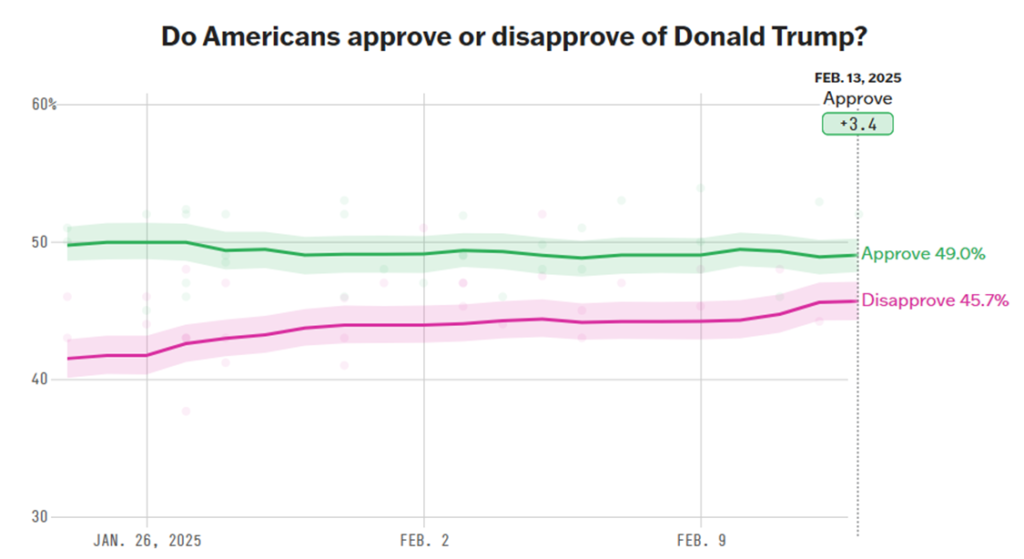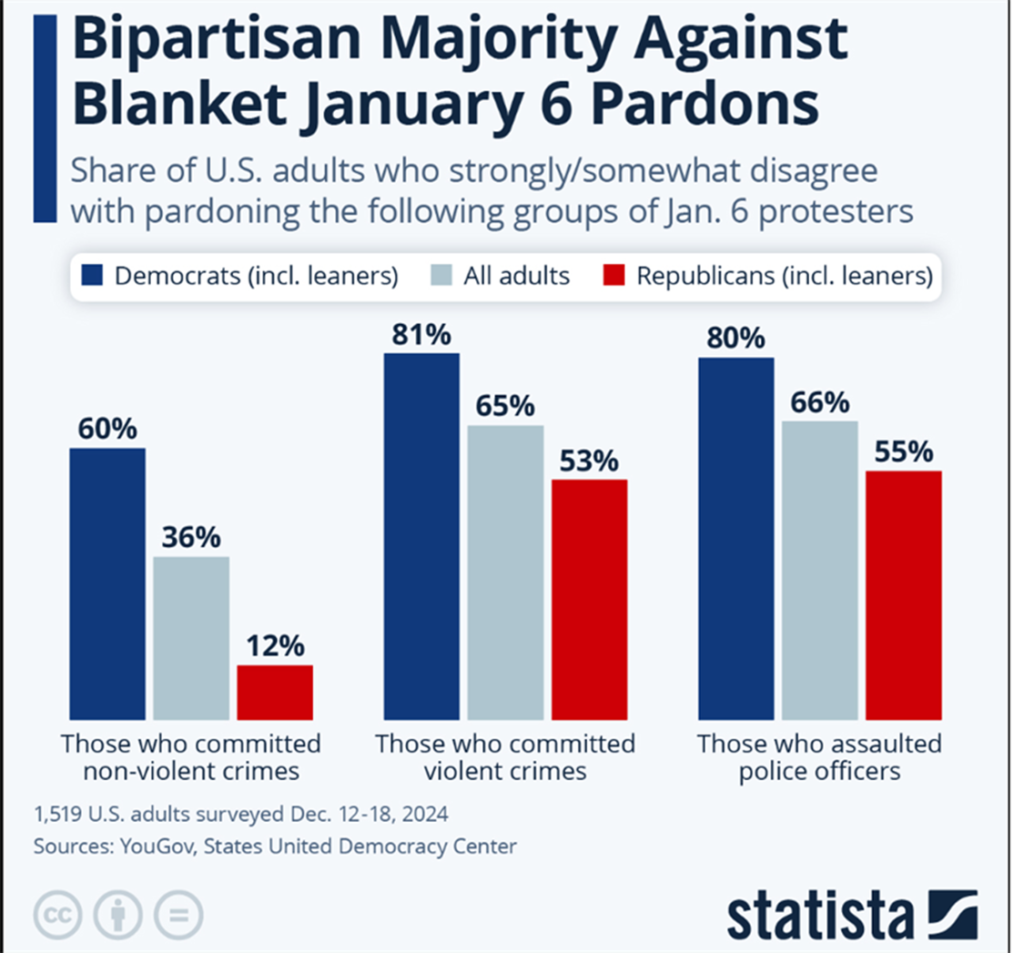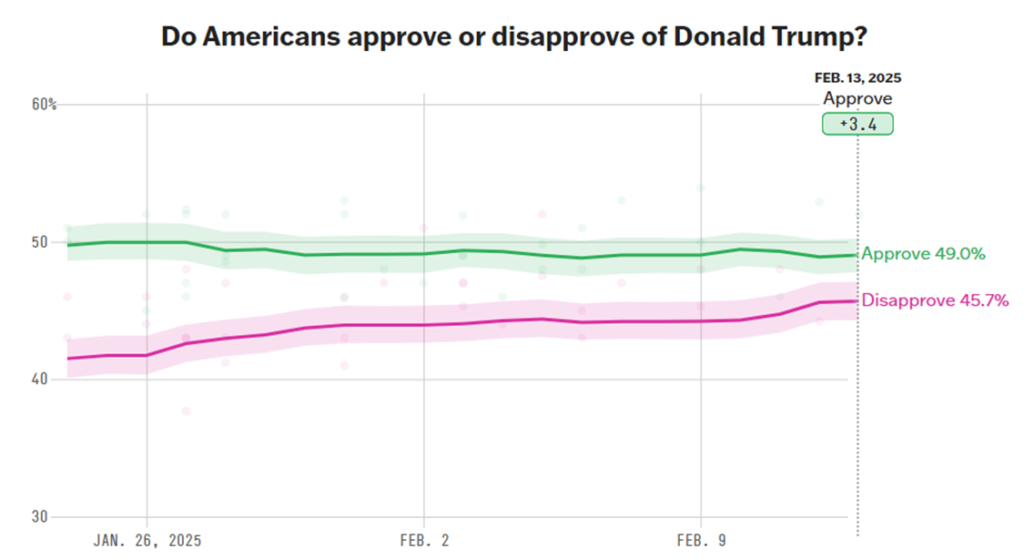Part 7 in a series of letters to Trump voters

The vast majority of you who voted for Trump undoubtedly remain in his corner and are gleeful about the start of his second term. The polls tell us that three weeks in, 90% of Republicans approve of his performance. I see everywhere that you applaud his “take no prisoners” approach to seize control and make good on campaign promises.
On the other hand, not all of you who voted for Trump identify as Republicans. About half of you who identify as independents voted for him. Also, an unprecedented number of you who identify as Democrats crossed over to vote for him. Put together, you gave Trump the popular vote victory, enabling him to claim a mandate for his entire policy agenda.
At this early stage in his second term it’s already apparent that a modest percentage of you who voted for Trump are having concerns. The President’s job approval numbers are slipping. This begs the question of whether it is a trend or whether the numbers will stabilize or rebound.
Let’s explore this question in this post. I’ll start by identifying some of the early evidence that Trump’s support is waning. We’ll explore where this slippage is coming from in terms of Democrats, independents, and Republicans. And, we’ll also explore the reasons for this decline. I’ll then offer some analysis on whether this drop in approval is likely to worsen, or whether it will stabilize or rebound. And, finally, I’ll discuss the implications for Trump’s presidency by examining what history teaches us.
Since President Trump entered office on January 20, 2025, he has taken numerous actions that are considerably more unpopular than popular.
Here are some of Trump’s early actions that are unpopular with Americans:
- Two-thirds of Americans do not approve of Trump’s pardoning criminal defendants convicted or charged with violent crimes or assaulting police officers in the January 6, 2021 insurrection at the Capitol. Even majorities of Republicans oppose blanket pardons for those who committed violent crimes of assaulted police officers.

- Americans do not approve of most of Trump’s proposals for expanding the territory of the United States, including pressuring Demark into selling or handing over control of Greenland to the United States, having Canada join the US as its 51st state, or using military force to obtain new territory.
- 59% of Americans oppose Trump’s executive order to end birthright citizenship for children born in American of illegal immigrant parents, while only 36% support this action.
- 56% of Americans oppose Trump’s proposal to dissolve the US Department of Education, while only 28% support this action.
- 50% of Americans oppose Trump’s firing FBI agents involved in the January 6th investigations, while only 32% support this action.
- 60% of Americans oppose new tariffs on goods from Canada, while only 37% support this action.
- 44% of Americans oppose removing Palestinians from Gaza (only 21% support), and 54% oppose the US owning Gaza (Economist/YouGov)
Trump’s approval numbers have already slightly declined since the election and since entering office.
Here is how several prominent polls reported Trump’s favorability and job approval ratings during the transition, upon entering office, and during his first month:
- Gallup reported that for the transition (December 2-18, 2024) Trump had a 51% approval. For his first week in office (January 21-27) he had 47% approval.
- Economist/YouGov found Trump had a 49% favorability rating on January 20th. On January 27, his initial job approval came in at 50%, On February 3, Trump had a 47.8% approval, down 2+ points from the previous week.. On February 9-11, Trump’s approval fell again to 46%, and went underwater, as 48% disapproved.
- Reuters/Ipsos found Trump had a 47% approval rating on January 21
- Rasmussen Reports, a conservative-leaning poll, found Trump had a 56% approval rating on January 23. On February 7, he was at 51%, a 6 point drop. Since then his approval rate has rebounded to 54% on February 14.
- Fivethirtyeight reports that for the period of January 24 to February 13, Trump’s approval rating declined from 49.7% to 49%. More significantly, there’s a trend of rising disapproval numbers (from 41.5% to 45.7%):

- Real Clear Politics (RCP) found that for the transition, President-elect Trump had a RCP average 50% approval. On Feb 12, the RCP average for the period of 1/20 to 2/12 was 48.8%. On Feb 11, the RCP average for the period of 1/20 to 2/11 fell to a 47.9% favorability rating, underwater to a 48.5% unfavorable rating (Note “approval” and “favorability” are two different factors).
- Pew Research, based on a Jan 27-Feb 2 survey, found that 47% approved of Trump’s performance, while 51% disapproved.
Trump is holding onto support from Republicans, but is losing support from independent voters.
Exit polls (CNN) for the 2024 election (November 5) show that:
- 4% of Democrats voted for Trump, while 95% voted for Harris
- 95% of Republicans voted for Trump, while 5% voted for Harris, and
- 46% of independents voted for Trump, while 49% voted for Harris
As to Trump’s first week in office (Jan 21-27), Gallup shows:
- 6% of Democrats approved of Trump’s performance
- 91% of Republicans approved of his performance, and
- 46% of independents approved of his performance
In the most recent Economist/YouGov poll (Feb 9-11, 2025)
- 7% of Democrats approved of Trump’s performance
- 91% of Republicans approved of Trump’s performance, and
- 39% of independents approved of Trump’s performance
The numbers show that Republicans are largely sticking with the President, as roughly 9 in 10 approve of his performance. On the other hand, while 46% of independents voted for Trump, in the most recent polls, only 39% of independents approve of his performance.
When it comes to the most important issues facing the country and Trump’s actions regarding federal agencies, many Americans have a dim view of his performance and actions.
Here are some noteworthy results for a recent poll (Economist/YouGov poll, Feb 9-11).
- 52% of Americans believe the country is off on the wrong track, including 59% of independents
- Most of the federal agencies that Trump is attacking are viewed favorably by Americans, including USAID (46% favorable vs. 30% unfavorable; the EPA (61% favorable vs 24% unfavorable); the National Oceanic and Atmospheric Administration (60% favorable and 10% unfavorable); the CIA (50% favorable vs 35% unfavorable); and the Consumer Finance Protection Bureau (50% favorable vs 19% unfavorable).
- On the other hand, support for the Department of Government Efficiency (DOGE) and Elon Musk is lukewarm. 40% view DOGE as favorable, while 38% view it as unfavorable. 42% view Elon Musk favorably, while 52% view him unfavorably. Also, 38% approve of Musk’s performance, while 47% disapprove.
- In terms of addressing the most important issue facing the country, Trump has low approval ratings.
- 23% of Americans named inflation and prices as the most important issue (41% approve of Trump’s handling and 48% disapprove; also 51% of independents disapprove of his handling)12% named health care (35% approve Trump’s handling vs 46% disapprove)10% named jobs and the economy (45% approve vs 44% disapprove)9% named immigration (this survey did not ask re Trump approval)
- 8% named taxes and government spending (44% approved Trump’s handling vs 47% disapprove.
- 58% oppose abolishing the Department of Education, while 28% support abolishment.
- 67% oppose abolishing the Occupational Safety and Health Administration (OSHA), while only 16% support
- 52% oppose ending humanitarian aid to foreign countries, while 35% support
It’s too early to predict whether Trump’s approval numbers will rebound or further decline in his first six months; but history says his numbers will decline before midway in his second term.
In the coming months, Trump may be able to broker an end to the war between Russia and Ukraine. If the public views the deal as fair to both Russia and Ukraine, this will should improve Trump’s approval rating, especially in the short run.
The same can be said about Trump’s success in securing passage of his key legislative initiatives: a Tax Cut package, an immigration and border enforcement package, and a package to reduce the cost of federal government. The contents of each of these packages will be critical, especially the tax cut and spending cut proposals.
Paying for the tax cuts—at least $4.5 trillion—will require deep cuts to other federal spending. Medicaid and SNAP (aka food stamps) have been put on the chopping block by Republicans. These programs serve tens of millions of Americans, including many poor Republicans living in rural areas. The cuts are likely to be unpopular with voters. In addition, voters may question why the richest Americans continue to get the biggest tax cuts. Why not just let tax cuts for wealthy Americans sunset in 2025? This would provide much of the revenue needed to pay for the tax cuts for ordinary Americans. Finally, given the razor-thin Republican majority in the House, it’s far from certain whether Trump will be able to secure passage of his legislative initiatives.
In addition, if inflation remains high, if the prices of gasoline and groceries don’t come down, and most Americans continue to struggle with their personal finances, Trump’s approval ratings are likely to decline during 2025.
In the longer run of the next two years, history says that Trump’s approval numbers are likely to decline. This is because voters tend to hold presidents accountable for negative conditions that occur during their terms. Voters expect presidents to fix problems and deliver on their campaign promises. And, given our hyper-partisan political system, the opposing party works hard to blame sitting presidents for any and all problems.
We can illustrate this dynamic by looking at the past three presidents:
Barack Obama entered office in his first term with a 67% approval rating. A half year in, his approval rating dropped to 56%; and at the end of his first year, it was 50%. After his healthcare reform (Affordable Care Act) passed in March of 2010, his ratings slipped further. At the time of the November 2010 midterms, his approval was at 45%. And at the end of two years, his approval inched up to 49%.
For his first term, Donald Trump entered office with a 44% approval rating. Early unpopular actions were a Muslim travel ban, questions about Steve Bannon’s role, and multiple firings related to the investigation of Russian influence in the 2016 election. A half year in, his approval rating dropped to 38%; and at the end of his first year, it was 36%. During this time he undertook unpopular attempts to repeal the Affordable Care Act, and cut Medicare and Medicaid. He also instituted a controversial family separation policy in his efforts to limit illegal immigration. By the time of the November 2018 midterms, his approval rating was at 40%. At the end of two years, his approval was at 37%.
Joe Biden entered office with a 57% approval rating. A half year in, his approval rating dropped to 49% as a new variant of Covid-19 surged. Then there was a botched withdrawal from Afghanistan in August 2021. At the end of his first year, his approval fell to 40%. Inflation surged around the world, and in the US peaked at 9.1% in June 2022. Republicans were successful in pinning the blame on Biden as his approval dropped to 38% in July. And by the time of the November 2022 terms, his approval was still low at 40%. At the end of two years, his approval rating was at 41%.
As Trump’s approval ratings go, so goes the Republican agenda and control of Congress as early as the November 2026 midterm elections.
History says that if Trump’s approval rating falls to 40%, or even to 45%, he could lose his majority in either the House or the Senate in the November 2026 midterms. Let’s see why.
With Barack Obama’s approval rating at 45% for the November 2010 midterms, Republicans gained control of the House of Representatives by a huge margin. Their net gain was 63 seats, giving them a 242 to 193 majority. While Obama was re-elected in 2012, Republicans retained their majority in the House. And, in the 2014 midterms, Republicans retained control of the House, 247 to 188.
With Trump’s first term approval rating at 40% for the November 2018 midterms, Democrats gained control of the House by a huge margin. Their net gain was 41 seats, giving them a 235 to 199 majority. Trump lost the November 2020 election, and Democrats retained control of the House and also gained control of the Senate.
With Biden’s approval rating at 40% for the November 2022 midterms, Republicans captured the House. They achieved a net gain of 9 seats, and a 222-213 majority. As Biden’s approval rating remained at or under 40% for the remainder of his term, Trump won the November 2024 election, along with the Senate, and continued, but narrow, control of the House.
To the extent that Trump can work successfully with his narrow majority in the House, he can enact significant portions of his legislative agenda in 2025 and 2026 without any votes from Democrats. But because Democrats have the ability to filibuster his proposals in the Senate, he will have to rely upon the “Budget Reconciliation” process that allows bills to pass with a simple majority. There are limits to the types of bills that can proceed via reconciliation; but it’s clear he can move his tax package, his border package, and his spending reduction proposals via this process.
But if Democrats were to capture either chamber of Congress in the 2026 midterms, Trump could no longer force his will on legislation. He will be required to compromise, and Democrats will certainly demand huge concessions to make up for all the legislation shoved down their throats. Trump and the Republicans know this, and that is why they are so intent on passing as much legislation as possible before the November 2026 midterms.
Final thoughts—Trump is hardwired to seize control and achieve his objectives through any means possible; but his success is likely to be short-lived if he alienates too many Americans with his ruthless and duplicitous leadership style.
Republicans clearly love and support Trump’s strong and decisive leadership style. He is acting with lightning speed, defying established processes, and taking unilateral action whenever possible. He hits first, intimidates, and takes control of the narrative through a dazzling array of soundbites. All too often, truth is not a requirement, and neither is evidence to back up his assertions.
On the other hand, most Democrats abhor the President. They see him as unethical, duplicitous, divisive, and vengeful. Yet, compared with 2020, a sizable number decided to vote for him in 2024. It remains to be seen whether their support will be sticky or transitory.
Independents are a mixed bag. While a majority voted for Biden in 2020, they broke for Trump in 2024. Now, just a month into his presidency, many independents seem to be having second thoughts.
To maintain or improve his approval ratings Trump needs to pull off the impossible. He needs to bring down inflation and the costs of groceries, gas and everything else. He needs pass a tax cut measure that his own party insists be paid for by massive cuts to popular programs. He needs to conduct mass deportations that will cost hundreds of billions and could upset the country’s labor market and economy. He needs to implement a series of tariffs that won’t be inflationary or spook the stock market. Yet if he pauses or foregoes these tariffs the promised boom in federal revenue won’t be realized. The list of difficult challenges goes on, but you get the picture.
Beyond these difficult challenges is the question of whether Trump’s leadership style is alienating an increasing percentage of Americans. Using Elon Musk, DOGE, and the Project 2025 playbook, Trump is shutting down agencies and Congressionally-approved funding with virtually no investigation. Sound bites and anecdotal evidence are being used as the basis for “deleting” agencies or “sending them to the woodchipper.” Agencies and government officials are condemned as corrupt, fraudulent, or wasteful; but they have not conducted or provided audits or detailed evidence to support their declarations. In addition, Trump has authored a host of executive orders that are illegal under current statutes and US Supreme Court decisions.
In the coming months public opinion polls and presidential approval ratings will tell us a lot about what Americans think of Trump’s efforts to pull off the impossible. The polls and ratings will also tell us a lot about what Americans think of Trump’s leadership style. I don’t think it looks good for Trump.
My research and analysis leads me to the conclusion that the President will only have limited success in pulling off the impossible. I say this not to disparage Trump, but rather because I don’t think anyone could pull off this daunting set of challenges.
I also believe that Americans will sour on Trump’s leadership style. They will have increasing concerns about preemptively shutting down agencies, firing employees, and freezing spending, especially when these actions are found to be illegal. It is inevitable, I believe, that there will negative repercussions from these actions. The unfortunate consequences will run the gamut: people will suffer and die, public safety will be compromised, and America will suffer a loss of respect in international relations.
I know that many of you who voted for Trump, probably the vast majority, disagree with my conclusions. But it’s not going to take that much of an erosion in his approval numbers to threaten the success of his presidency. If you still don’t agree with me, let’s just see what happens in the next six to twelve months.
Leave a Reply